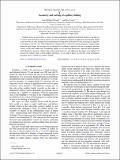| dc.contributor.author | Lauga, Eric | |
| dc.contributor.author | Peraud, Jean-Philippe Michel | |
| dc.date.accessioned | 2014-08-25T18:52:02Z | |
| dc.date.available | 2014-08-25T18:52:02Z | |
| dc.date.issued | 2014-04 | |
| dc.date.submitted | 2013-10 | |
| dc.identifier.issn | 1539-3755 | |
| dc.identifier.issn | 1550-2376 | |
| dc.identifier.uri | http://hdl.handle.net/1721.1/89040 | |
| dc.description.abstract | Capillary forces are involved in a variety of natural phenomena, ranging from droplet breakup to the physics of clouds. The forces from surface tension can also be exploited in industrial applications provided the length scales involved are small enough. Recent experimental investigations showed how to take advantage of capillarity to fold planar structures into three-dimensional configurations by selectively melting polymeric hinges joining otherwise rigid shapes. In this paper we use theoretical calculations to quantify the role of geometry and fluid wetting on the final folded state. Considering folding in two and three dimensions, studying both hydrophilic and hydrophobic situations with possible contact-angle hysteresis, and addressing the shapes to be folded to be successively infinite, finite, curved, kinked, and elastic, we are able to derive an overview of the geometrical parameter space available for capillary folding. | en_US |
| dc.language.iso | en_US | |
| dc.publisher | American Physical Society | en_US |
| dc.relation.isversionof | http://dx.doi.org/10.1103/PhysRevE.89.043011 | en_US |
| dc.rights | Article is made available in accordance with the publisher's policy and may be subject to US copyright law. Please refer to the publisher's site for terms of use. | en_US |
| dc.source | American Physical Society | en_US |
| dc.title | Geometry and wetting of capillary folding | en_US |
| dc.type | Article | en_US |
| dc.identifier.citation | Peraud, Jean-Philippe, and Eric Lauga. “Geometry and Wetting of Capillary Folding.” Phys. Rev. E 89, no. 4 (April 2014). © 2014 American Physical Society | en_US |
| dc.contributor.department | Massachusetts Institute of Technology. Department of Mechanical Engineering | en_US |
| dc.contributor.mitauthor | Peraud, Jean-Philippe Michel | en_US |
| dc.relation.journal | Physical Review E | en_US |
| dc.eprint.version | Final published version | en_US |
| dc.type.uri | http://purl.org/eprint/type/JournalArticle | en_US |
| eprint.status | http://purl.org/eprint/status/PeerReviewed | en_US |
| dspace.orderedauthors | Peraud, Jean-Philippe; Lauga, Eric | en_US |
| dc.identifier.orcid | https://orcid.org/0000-0001-9070-6231 | |
| mit.license | PUBLISHER_POLICY | en_US |
| mit.metadata.status | Complete | |
